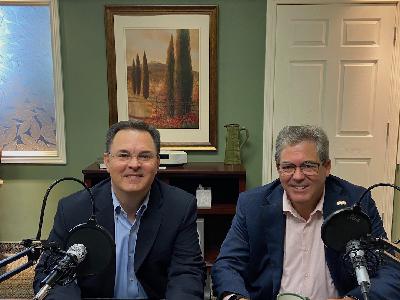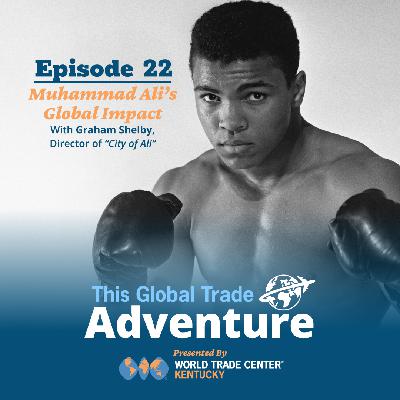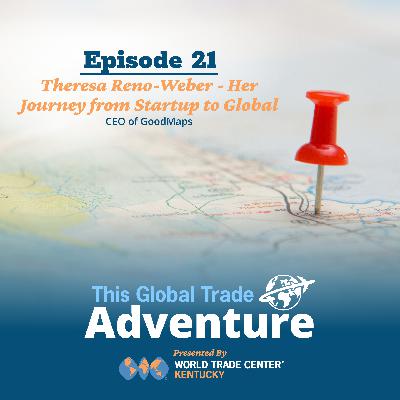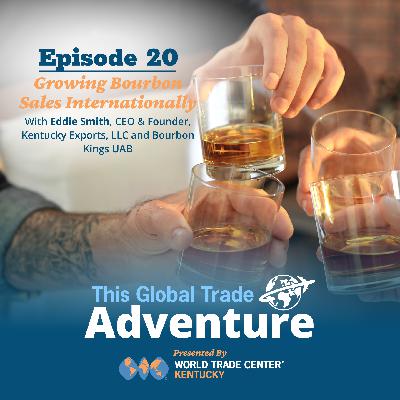The Rise of Bourbonism: An Interview with Eric Gregory
Description
Episode 25: Today, Omar Ayyash, President & CEO of the World Trade Center Kentucky interviews Eric Gregory, President of the Kentucky Distiller's Association discuss the Kentucky bourbon industry, its history, standards, and the challenges it faces in the global market. They explore the rise of bourbonism, the impact of tariffs on exports, and the importance of tourism in promoting Kentucky's bourbon heritage. The conversation highlights the collaborative spirit of the distillers and the economic significance of bourbon to the state of Kentucky.
Meet Eric Gregory
Eric is a born and raised Kentuckian, from Henderson County. He attended the University of Kentucky. He has a background in journalism, public relations and political consulting. He later became a lobbyist. In 2007, he became the President of the Kentucky Distillers' Association (KDA). He considers it an honor and privilege to have played a role in the incredible rise in the popularity of bourbon and bourbonism during the past 10-15 years.
What Is the Kentucky Distillers' Association?
Eric notes the KDA was founded in 1880. A group of distillers met at the Galt House in Louisville to discuss how they could better deal with the increasing taxes on bourbon. Labeling and whether a spirit was truly bourbon or not were other important themes, in the early years.
The mission of the Kentucky Distillers' Association is to protect, promote and elevate Kentucky's signature bourbon and distilled spirits industry. Over 100 Kentucky distilleries are members of the KDA. These distilleries produce 95% of the world's bourbon.
There is also a significant tourism arm of the KDA. In 1999, the KDA launched the Kentucky Bourbon Trail Experience. It's focus is to promote bourbonism throughout the Commonwealth and beyond.
What Makes Bourbon Different from Whiskey?
To begin, all bourbon is whiskey, but not all whiskey is bourbon. The KDA's website has some very interesting FAQs about bourbon. There are actual federal standards that define elements which qualify a spirit to be called bourbon.
Primarily, the spirit must be at least 51% corn and it must be aged in a brand new, charred oak container. Additionally, it can't be bottled at less than 80 proof. It can't go into the barrel if it exceeds 125 proof.
To be called a Kentucky bourbon, it must be fermented, distilled and produced in Kentucky. Additionally, it must be aged in the Commonwealth for at least 1 year. If the label calls it a "straight bourbon," that indicates it's been aged for at least 2 years. If there is no aged statement on the bottle, that means it's at least 4 years old.
Eric points out that bourbon is the only indigenous spirit of the United States. In 1964, Congress passed a law requiring the whiskey to be made in the US, if it's to be called a bourbon.
Bourbon Is Steeped in Family Tradition
Bill Samuels is a legend in Kentucky bourbon. He's the son of the founder of Makers Mark. His godfather was Colonel Jim Beam. Many of the families behind some of the most recognized brands are related, along the way. Eric describes how many of the family names are iconic throughout the world, as it relates to distilled spirits.
It's important to note that the distilleries all get along with each other, based in part because of the 200-year family heritage. Through the years many of the distilleries have helped their competitors in times of emergencies, such as floods and fires.
The Bourbon-Boom and the Global Phenomenon of Bourbonism
While bourbon was popular in the 50's, it experienced a decline during the 60s and 70s. It was no longer considered hip or cool. The consumer began demonstrating a preference for clear spirits. This trend continued into the 1980s.
Eric points out that Kentucky had 8,000,000 barrels of bourbon in 1960s to 2,000,000 barrels or less in during that decline.
In the 1980s, the distillers began producing single-barrel and small-batch bourbons. Blantons, Knob Creek, Basil Hayden and Booker's are a few important examples. The quality of these product were very high.
In the 1990s, international free-trade agreements (such as NAFTA and with the EU) contributed to the expansion of Kentucky bourbon. Tariffs were set at zero, enabling distillers and the KDA to sell to new markets that were unfamiliar with Kentucky bourbon.
Other factors include the increase in bourbon tourism and the rise of the cocktail culture in the US. Bourbonism was surging and it began to reclaim that dominant image position, across the US and beyond.
In 1999, as a state, Kentucky filled 455,000 barrels of bourbon. In 2024, it had risen to 3.2 million barrels. Production has substantially increased to meet the growing demand.
Challenges and Opportunities Facing the Bourbon Industry
Omar asks Eric to discuss some of the issues impacting bourbon sales both domestically and globally. The obvious factor today is tariffs. Between 2009 and 2017, before the tariffs, bourbon exports were growing at roughly 150%. The industry has invested billions of dollars in new distilleries, bottling lines and aging houses.
In 2018, the first tariffs on steel and aluminum hit. It crushed that 150% growth rate. In 2024-2025, global exports of bourbon have dropped 20%. The Kentucky Distillers' Association has been working with global trade association partners to educate world leaders on the impact of tariffs. The pain and damage will surpass the distillers and begin to negatively impact farmers, loggers and other constituents in the supply chain.
In Episode 20, we interviewed Eddie Smith, Kentucky Exports and Bourbon Kings, the tariff discussion was a significant topic during our conversation.
Omar comment on the recent growth of Kentucky exports, in general. In 2022, we exported $32 billion. In 2023, we exported $40 billion. In 2024, we reached $48 billion. Unfortunately, there's a risk Kentucky exports may not fare as well in 2025.
Working to Remove Barriers to Global Markets
While tariffs are the primary focus, currently, other factors exist. India is the world's largest market for spirits. They had a 150% tariff on bourbon, even before the most recent round of tariffs. Imagine the opportunity if only 1% of India's population became bourbon drinkers. The bourbon tariff in India has been reduced to 100%, thanks in part to the efforts of Kentucky Congressman Andy Barr.
The KDA recently met with members of the Scotch-Whisky Association. Both members of both organizations are facing similar issues. Eric mentions the KDA has been heavily involved in advocating for more free trade agreements for 30-40 years.
Market penetration, especially on a global scale, requires investments of both money and time. It doesn't happen overnight. Because Kentucky bourbon will age for years, before it's potentially sold into global markets, the immediate impact of tariffs and other trade barriers on the market potential is critical for Kentucky distillers. How much investment can a brand make to cultivate a market, knowing significant tariffs my make it even more difficult to grow and maintain market share in a particular country or region? It's serious issue.
"We're a Pretty Resilient Industry"
Eric notes the bourbon industry survived prohibition. He remains positive in the industry's ability to withstand the headwinds and to return to a period of growth on a global scale.
Canada is Kentucky's largest export country. The EU is our largest export market. Canada responded with additional tariffs and actually removed bourbon from its shelves. This virtually eliminated our ability to compete for Cana












